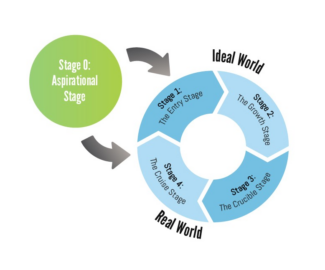Knowing the Flow: Organizational Life Cycles
It’s a time of transition for many of us. Summer is ending, school is starting, fall is on the horizon. It’s also a time of change for our little firm. We are now 8 years old and have steadily grown from a one-woman team to 10 times that. We’ve earned a solid reputation for facilitating authentic, collaborative processes and we now have the fortunate burden of needing to plan for more. More work, more variables, more management.
Charlie Gilkey describes what we’re going through as “The Crucible Stage” in his Small Business Life Cycle model:

We’ve already been through the Aspirational, Entry, and Growth stages: we started the business, built our core markets and services, and have grown our demand to a point where we find ourselves needing to level-up our business management and organizational systems and practices. We have entered Gilkey’s “Real World” (although if these past 8 years haven’t been real, we don’t know what is!).
Still, the Crucible Stage gives us a clue that we are at an important “crisis point” in the lifecycle of an organization. Experiencing discomfort in an organization is often an important clue that something needs to change. We need to look at our new reality and figure out what could get in the way of our continuing to take on the work we want, we’re good at, and that people are knocking on our door for. And then we need to make adjustments.
To begin, we used our Time Reality Check-In to identify personal and organizational needs, then identified gaps in our resources. After many discussions, we’ve determined that our systems and administrative capacity are the primary growth needs and we’re making and investing in changes to bring that capacity to the new reality of our business.
Organizational life cycle models are incredibly useful for strategic planning and analyzing everyday operations and performance. They help an organization use their past experiences to inform their future, a key strategic planning approach! Gilkey’s model was very relevant in illustrating where we found ourselves in the lifecycle of our small business. Here are some others that may help you identify where you are in your group’s lifecycle and to harness and navigate the growth you want to see:
The Greiner Curve, by Larry Greiner. Best for large or aspiring-to-be-large businesses.
Nonprofit Lifecycles, by Susan Kenny Stevens Ph.D. Best for nonprofit organizations.
Various models described by the Academy to Innovate HR
